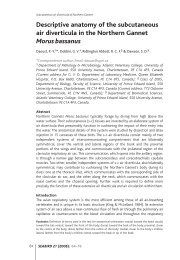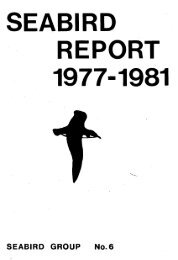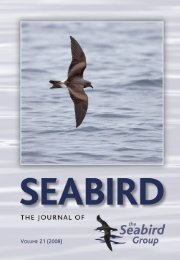Create successful ePaper yourself
Turn your PDF publications into a flip-book with our unique Google optimized e-Paper software.
146 P.H. BECKER Atlantic <strong>Seabird</strong>s 3(4)<br />
breeding ecology of southern hemisphere seabirds; (d) reproductive success, and<br />
(e) food provisioning and foraging.<br />
Two notable keynote talks were presented by Ian L. Jones, St. John’s,<br />
Canada on “Life history implications of mate choice, mating success and sexual<br />
selection in seabirds “, and by Pat Monaghan, Glasgow, United Kingdom on<br />
“Resource allocation and life history trade-offs in seabirds”. <strong>The</strong> programme<br />
reflected the wide diversity of the research that is currently being carried out on<br />
marine birds, and the rapid progress that has been made in recent years through<br />
the use of new laboratory and field techniques. With most, if not all, marine<br />
environments currently threatened by a wide range of anthropogenic activities,<br />
the need for research on seabirds has never been greater.<br />
<strong>Seabird</strong> <strong>Group</strong> Conferences are well respected for their scientific<br />
reputation and for the high quality of contributions. It comes as no surprise,<br />
therefore, that just one year after the conference many of the papers given have<br />
already been published and can be found spread over the various ecological and<br />
ornithological journals. For this reason we have not been able to prepare<br />
complete conference proceedings, such as in the last conference co-organised by<br />
the <strong>Seabird</strong> <strong>Group</strong> and ICES (Reid 1997). We have seized the chance, however,<br />
to publish a selection of papers in this special issue of Atlantic <strong>Seabird</strong>s,<br />
issueing from the conference in Wilhelmshaven above and beyond the Abstract<br />
Booklet available (Tasker 2000). <strong>The</strong> generosity of the sponsors of the<br />
conference, especially of the main supporters of this special issue, the<br />
organisations “Bürger für Wilhelmshaven” and the “Gerd-Möller-Stiftung”,<br />
have made possible this much appreciated service both to the participants of the<br />
meeting and to the members of the <strong>Seabird</strong> <strong>Group</strong> and the Dutch <strong>Seabird</strong> <strong>Group</strong>,<br />
whose official journal Atlantic <strong>Seabird</strong>s is.<br />
<strong>The</strong> present special issue contains five selected papers presented at the 7 th<br />
International <strong>Seabird</strong> <strong>Group</strong> Conference which reflect the main themes of the<br />
conference programme.<br />
Bernard Cadiou reports on the great interannual variation in the timing of<br />
breeding and the reproductive success of European Storm-petrels Hydrobates<br />
pelagicus in Brittany, which was probably due to changing food availability and<br />
has implications for census timing. Ingveig Langseth, Børge Moe and Claus<br />
Bech address the question of whether reductions in body mass and basal<br />
metabolic rate in Black-legged Kittiwakes Rissa tridactyla during chick rearing<br />
may be an adaptation aimed at reducing maintenance costs in favour of<br />
investing more energy in chick growth. <strong>The</strong> return rates of subadult Common<br />
Terns Sterna hirundo to their natal colony are not affected by parameters of the<br />
individuals’ chick period such as hatching position or number of fledged<br />
siblings, as Tobias Dittmann, Jan-Dieter Ludwigs and Peter H. Becker show,<br />
using new techniques to record breeders and non-breeders remotely and








